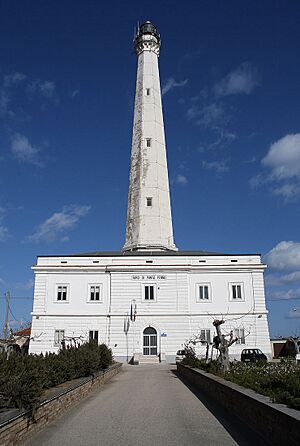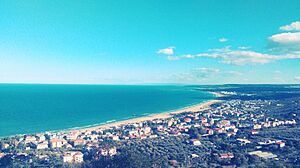Vasto facts for kids
Quick facts for kids
Vasto
|
|||
|---|---|---|---|
| Città del Vasto | |||

Lighthouse of Punta Penna, the second tallest in Italy and seventh tallest in the world
|
|||
|
|||
| Country | Italy | ||
| Region | Abruzzo | ||
| Province | Chieti (CH) | ||
| Area | |||
| • Total | 70.65 km2 (27.28 sq mi) | ||
| Elevation | 138 m (453 ft) | ||
| Population
(January 1, 2023)
|
|||
| • Total | 40,692 | ||
| • Density | 575.97/km2 (1,491.75/sq mi) | ||
| Demonym(s) | Vastesi | ||
| Time zone | UTC+1 (CET) | ||
| • Summer (DST) | UTC+2 (CEST) | ||
| Postal code |
66054
|
||
| Dialing code | 0873 | ||
| Patron saint | Saint Michael | ||
| Saint day | September 29 | ||
Vasto is a beautiful town located on the Adriatic coast in the Abruzzo region of Italy. It's known as a comune, which is like a municipality or a local government area in Italy. Vasto has a long and interesting history, with different names over time. In the Abruzzese dialect, it's called lù Uàštë. Long ago, the ancient Greeks and Romans knew it as Histonion. During the Middle Ages, it was called Guastaymonis or Vasto d'Aimone. For a short time, from 1938 to 1944, it was even called Istonio again.
Contents
Discovering Vasto's Past
How Old is Vasto?
Legend says that the Greek hero Diomedes founded Vasto. This would make it very, very old! We know for sure that people lived here as far back as 1300 BC. That's over 3,300 years ago!
Vasto was an important town for the Frentani people. They lived along the Adriatic coast. Later, under the Roman Empire, Vasto was a rich and busy town. You can still see parts of ancient Roman buildings today. These include a theatre, baths, and beautiful mosaics. Many statues and columns have also been found.
One cool story from Roman times is about a boy named Lucius Valerius Pudens. When he was just thirteen, he won a poetry contest in Rome! This contest was held in the temple of Jupiter Capitolinus. Vasto has been attacked many times throughout history. The Goths, Lombards, Franks, and Arabs all caused damage.
Vasto didn't have a natural port right in the town. It probably used the port at Punta Penna. This is where the modern harbour and the lighthouse are today.
Vasto in the Middle Ages
After the Roman Empire ended, different groups took over Vasto. First, Germanic tribes arrived. Then, the Byzantine Empire took control. But soon, the Lombards conquered it. Around 774 AD, the Franks took over. In 1053, the Normans captured the town.
Around 1076, Vasto was renamed Guastaymonis. This means "the Waste of Aimone," because of attacks. From the 13th century, Vasto was part of the Kingdom of Naples. This kingdom later joined with others to form the Kingdom of the Two Sicilies.
In the 15th century, a leader named Giacomo Caldora changed the town's look. He built new city walls. You can still see parts of these walls today. They include towers like Torre Bassano and Torre Diomede. The main defense was the Castello Caldoresco castle.
In 1566, Turkish forces attacked Vasto. They burned much of the city. The Castello Caldoresco, the Church of Santa Margherita, and the Palazzo d'Avalos were all damaged.
From Spanish Rule to Modern Times
Under Spanish rule, Vasto became a property of the Marquis d'Avalos family. The town was at its best during the time of Cesare Michelangelo d'Avalos (1697-1729).
In the early 1900s, Vasto started to change. New buildings were added. In the 1920s and 1930s, big changes happened. In 1938, the leader Mussolini changed the town's name back to Istonio. But in 1944, when Allied Forces freed the city, it went back to being called Vasto.
After World War II, Vasto grew a lot. Even after a big landslide in 1956, the town developed. Industries grew, and more people moved there. Vasto also became a popular place for tourists. Its beaches in Marina di Vasto became famous. Old Roman ruins, like thermal baths and mosaics, were found and fixed up.
Since the 1970s, Vasto has continued to grow quickly. Many new homes and roads were built. This made Vasto one of the most populated towns in its region.
What to See in Vasto
The old part of Vasto, called the centro storico, has many old buildings. These include churches from the 12th to 18th centuries.
- Vasto Cathedral (Cattedrale di San Giuseppe): This is the main church in Vasto.
- Santa Maria Maggiore: This is the biggest and oldest church in town. It was first mentioned in 1195! It has a very tall bell tower. The church was damaged by Turks in 1566 and by fire in 1645. It was rebuilt in 1735. It is said to hold one of Jesus' crown of thorns.
- Castello Caldoresco: This is the historic castle in Vasto.
- Palazzo D'Avalos: This is a grand palace in the town center. Today, it holds the Civic Museums. These include a museum of archeology and the town's Art Gallery (Musei Civici).
Below the main town, you'll find Marina di Vasto. This is a beach resort town. It has a large sandy beach and many hotels.
North of Vasto, the coast becomes rocky. You can find interesting pebble and stone beaches there. You'll also see trabocchi. These are special wooden fishing machines unique to the Abruzzo coast.
One beautiful natural area is the Riserva Naturale di Punta Aderci. It has sandy and rocky beaches. In 2014, its beaches were voted among the top 20 beaches in Italy!
Famous People from Vasto
Vasto has been home to several notable people:
- Gabriele Rossetti: A scholar and poet. He was also a founder of a secret society called the Carbonari. His children, Dante Gabriel Rossetti and Christina Rossetti, became famous artists and poets in England.
- Vittorio Coccia: A football player.
- Andrea Iannone: A motorcycle racer.
- Valerico Laccetti: A painter.
- Filippo Palizzi: A painter.
- Francesco Romani: A doctor.
- Alessandra Smerilli: An economist.
- Giuseppe Spataro: A politician.
Vasto's Weather
| Climate data for Vasto (1991–2020 normals, extremes 1951–2000) | |||||||||||||
|---|---|---|---|---|---|---|---|---|---|---|---|---|---|
| Month | Jan | Feb | Mar | Apr | May | Jun | Jul | Aug | Sep | Oct | Nov | Dec | Year |
| Record high °C (°F) | 23.0 (73.4) |
24.5 (76.1) |
28.0 (82.4) |
29.1 (84.4) |
34.8 (94.6) |
38.4 (101.1) |
40.2 (104.4) |
42.5 (108.5) |
38.5 (101.3) |
33.2 (91.8) |
27.2 (81.0) |
24.3 (75.7) |
42.5 (108.5) |
| Mean daily maximum °C (°F) | 10.5 (50.9) |
11.0 (51.8) |
13.9 (57.0) |
17.3 (63.1) |
21.6 (70.9) |
25.9 (78.6) |
28.5 (83.3) |
28.7 (83.7) |
24.3 (75.7) |
20.0 (68.0) |
15.6 (60.1) |
11.7 (53.1) |
19.1 (66.4) |
| Daily mean °C (°F) | 7.7 (45.9) |
8.0 (46.4) |
10.6 (51.1) |
13.8 (56.8) |
17.9 (64.2) |
22.1 (71.8) |
24.7 (76.5) |
24.9 (76.8) |
20.7 (69.3) |
16.8 (62.2) |
12.7 (54.9) |
8.9 (48.0) |
15.7 (60.3) |
| Mean daily minimum °C (°F) | 4.9 (40.8) |
5.0 (41.0) |
7.2 (45.0) |
10.2 (50.4) |
14.2 (57.6) |
18.4 (65.1) |
21.0 (69.8) |
21.1 (70.0) |
17.1 (62.8) |
13.6 (56.5) |
9.7 (49.5) |
6.2 (43.2) |
12.4 (54.3) |
| Record low °C (°F) | −6.4 (20.5) |
−6.8 (19.8) |
−5.0 (23.0) |
0.9 (33.6) |
2.5 (36.5) |
9.3 (48.7) |
12.0 (53.6) |
10.0 (50.0) |
8.0 (46.4) |
4.0 (39.2) |
−8.0 (17.6) |
−3.8 (25.2) |
−8.0 (17.6) |
| Average precipitation mm (inches) | 63.3 (2.49) |
53.0 (2.09) |
59.7 (2.35) |
51.2 (2.02) |
36.8 (1.45) |
33.0 (1.30) |
35.2 (1.39) |
42.2 (1.66) |
63.0 (2.48) |
75.0 (2.95) |
81.4 (3.20) |
87.1 (3.43) |
680.9 (26.81) |
| Average precipitation days | 7.1 | 6.2 | 6.8 | 5.5 | 4.8 | 3.7 | 3.3 | 3.7 | 4.9 | 6.6 | 7.8 | 7.7 | 68.1 |
| Source 1: Istituto Superiore per la Protezione e la Ricerca Ambientale | |||||||||||||
| Source 2: Regione Abruzzo (precipitation and extremes 1951–2000) | |||||||||||||
Sister Cities
Vasto has a special connection with another city far away. It is twinned with:
Images for kids
See also
 In Spanish: Vasto para niños
In Spanish: Vasto para niños









